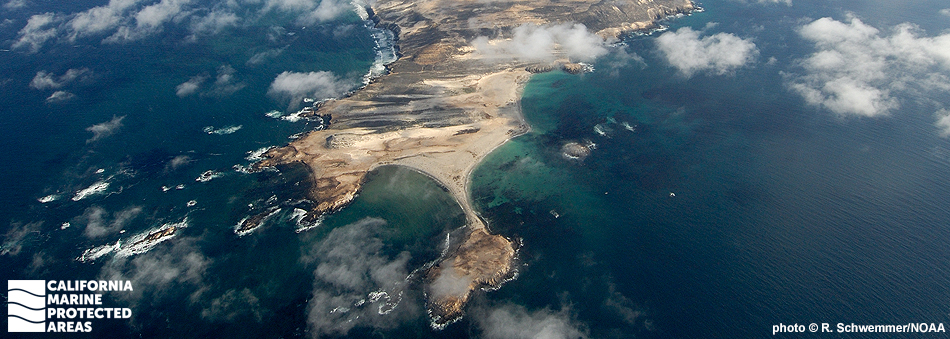
Overview
Judith Rock State Marine Reserve (SMR) lies on the southwest coast of San Miguel Island, the westernmost of California’s Channel Islands. This marine protected area (MPA) protects more than 4½ square miles of ocean habitat including surfgrass beds, rocky reefs, and kelp forests, and reaches depths approaching 500 feet.
Cold water from the north and warm water from the south mix here, creating complex circulation patterns and species diversity. Marine life in the waters surrounding San Miguel Island most closely resembles northern California's because of the strong influence of cold waters from the north. Invertebrates such as mussels, anemones, abalone, and barnacles thrive in the reserve’s rocky intertidal area, and sculpins and other small fish find refuge in bedrock pools. The SMR's extensive kelp forests are home to lingcod, kelp bass, and rockfish.
San Miguel Island Special Closure runs the length of the island's western coastline, from Castle Rock to Judith Rock. The special closure (and the reserve) protects some of the largest seal and sea lion rookeries in the country. Several species can be spotted, especially on sandy beaches. In winter, as many as 50,000 seals and sea lions haul out at Point Bennett, a promontory connected to the main island by stretches of sandy beach. To give them a safe place to haul out and give birth, the year-round special closure prohibits boats from approaching the shore closer than 300 yards. However, from March 15 through April 30, and October 1 through December 15, the closure is reduced to 100 yards from shore. Other prohibitions exist as well in this unique area.
Although not out of reach, visiting San Miguel Island requires a three-to-four-hour boat ride from Ventura Harbor.
Regulations
Judith Rock SMR
It is unlawful to injure, damage, take, or possess any living, geological, or cultural marine resource.
California Code of Regulations Title 14, Section 632(b)(104)(opens in new tab)
San Miguel Island Special Closure
Boating, access, and other specific activities are restricted.
300 yd. closure except:
The closure is reduced to 100 yd. from March 15 through April 30, and October 1 through December 15.
Boats operated by commercial sea urchin divers may enter certain areas only between March 15 and April 30, and October 1 through December 15.
Additional restrictions exist for boating speed limits, noise, anchoring, landing, and access to offshore rocks and islands. See CCR T14 §632(b) (link below) for details.
California Code of Regulations Title 14, Section 632(b)(102)(opens in new tab)
Quick Facts
Judith Rock SMR
MPA size: 4.56 square miles
Shoreline span: 1.4 miles
Depth range: 0 to 487 feet
Habitat composition*:
- Rock: 0.54 square miles
- Sand/mud: 1.78 square miles
San Miguel Island Special Closure
Special Closure size: 0.86 square miles
Depth range: 0 to 55 feet
Habitat composition*:
- Rock: 0.71 square miles
- Sand/mud: 0.01 square miles
*Habitat calculations are based on three-dimensional area and may exceed the total MPA area listed above.